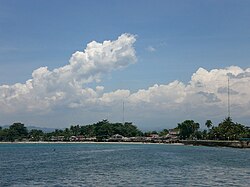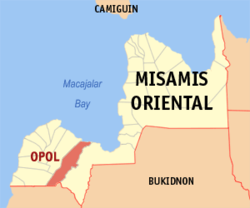Opol
Opol | |
|---|---|
| Municipality of Opol | |
 Opol Waterfront | |
 Map of Misamis Oriental with Opol highlighted | |
Location within the Philippines | |
| Coordinates: 8°31′N 124°34′E / 8.52°N 124.57°E | |
| Country | |
| Region | Northern Mindanao |
| Province | Misamis Oriental |
| District | 2nd District |
| Founded | June 15, 1950 |
| Barangays | 14 (see Barangays) |
| Government | |
| • Type | Sangguniang Bayan |
| • Mayor | Maximino B. Seno |
| • Vice Mayor | Louie Mark N. Neri |
| • Representative | Juliette T. Uy |
| • Electorate | 38,811 voters (2022) |
| Area | |
| • Total | 175.13 km2 (67.62 sq mi) |
| Elevation | 25 m (82 ft) |
| Population (2020 census)[3] | |
| • Total | 66,327 |
| • Density | 380/km2 (980/sq mi) |
| • Households | 16,210 |
| Economy | |
| • Income class | 2nd municipal income class |
| • Poverty incidence | 20.66% (2015)[4] |
| • Revenue | ₱ 267.2 million (2020) |
| • Assets | ₱ 631 million (2020) |
| • Liabilities | ₱ 180.4 million (2020) |
| • Expenditure | ₱ 231 million (2020) |
| Time zone | UTC+8 (PST) |
| ZIP code | 9016 |
| PSGC | |
| IDD : area code | +63 (0)88 |
| Native languages | Cebuano Binukid Subanon Tagalog |
| Website | www |
Opol, officially the Municipality of Opol (Cebuano: Lungsod sa Opol; Tagalog: Bayan ng Opol), is a 2nd class municipality in the province of Misamis Oriental, Philippines. According to the 2020 census, it has a population of 66,327 people.[3]
Opol was created from the barrios of Opol, Igpit, and Lower Iponan, formerly part of Cagayan de Oro, by virtue of Republic Act No. 524, approved June 15, 1950.[5]
The municipality is gradually becoming more urbanized, as a result of local population growth and the expansion of nearby Cagayan de Oro City. Historically, Opol was a more rural area focused on agriculture and fishing. The subdivision of rural land for new residential housing is a matter of some controversy amongst locals. The current Mayor, Maximino B. Seno (known as "Max Seno"), has held office in Opol after Dexter Yasay.
Barangays
Opol is politically subdivided into 14 barangays.
- Awang
- Bagocboc
- Barra
- Bonbon
- Cauyonan
- Igpit
- Limonda
- Luyong Bonbon
- Malanang
- Nangcaon
- Patag
- Poblacion
- Taboc
- Tingalan
Climate
| Climate data for Opol, Misamis Oriental | |||||||||||||
|---|---|---|---|---|---|---|---|---|---|---|---|---|---|
| Month | Jan | Feb | Mar | Apr | May | Jun | Jul | Aug | Sep | Oct | Nov | Dec | Year |
| Mean daily maximum °C (°F) | 28 (82) |
29 (84) |
30 (86) |
31 (88) |
30 (86) |
30 (86) |
30 (86) |
30 (86) |
30 (86) |
30 (86) |
29 (84) |
29 (84) |
30 (85) |
| Mean daily minimum °C (°F) | 24 (75) |
24 (75) |
24 (75) |
25 (77) |
26 (79) |
26 (79) |
25 (77) |
25 (77) |
25 (77) |
25 (77) |
25 (77) |
25 (77) |
25 (77) |
| Average precipitation mm (inches) | 271 (10.7) |
217 (8.5) |
193 (7.6) |
178 (7.0) |
344 (13.5) |
423 (16.7) |
362 (14.3) |
358 (14.1) |
329 (13.0) |
320 (12.6) |
322 (12.7) |
260 (10.2) |
3,577 (140.9) |
| Average rainy days | 23.2 | 19.5 | 22.0 | 22.8 | 29.6 | 28.9 | 30.3 | 29.8 | 28.1 | 28.8 | 26.1 | 24.1 | 313.2 |
| Source: Meteoblue [6] | |||||||||||||
Demographics
|
| |||||||||||||||||||||||||||||||||||||||
| Source: Philippine Statistics Authority[7][8][9][10] | ||||||||||||||||||||||||||||||||||||||||
In the 2020 census, the population of Opol, Misamis Oriental, was 66,327 people,[3] with a density of 380 inhabitants per square kilometre or 980 inhabitants per square mile.
Economy
Key economic activities in Opol include commercial fishing, farming, tourism/hospitality, and light industry. Notable economic infrastructure includes the San Miguel/Coca-Cola bottling plant, Lechem Food Marketing, and fishing port at Luyong-Bonbon as well as the municipal market building, located adjacent to the Opol municipal centre.
The Cagayan de Oro - Iligan highway passes through Opol, alongside the coast. The highway is a key inter-regional transport route and comprises an integral part of the Cagayan de Oro - Iligan Corridor Special Development Project. This is a major infrastructure development initiative which is likely to result in significant economic growth for Opol, Misamis Oriental and the adjoining province of Lanao del Norte in coming years.
Attractions
- Philippine Ostrich & Crocodile Farm is the first combined ostrich and crocodile farm in the Philippines. The farm is home to several hundred ostrich and several dozen crocodiles, with both species being cultivated for leather and meat. The farm is open to the public for supervised tours.
- Apple Tree Beach Resort (formerly called Lauremar Beach Resort, after being under new management) is a popular tourist resort located on the main beach in central Opol.
- Opol Aviary and Mini Zoo features a wide variety of native birds and animals (Closed as of 2014).
- San Pedro Beach Resort is the first beach resort in Misamis Oriental. With big halls and cottages that could cater to seminars, weddings and other large gatherings. It also has medium to small size open air cottages for cozy and more private family or friends gathering. It also has affordable air-conditioned rooms with own bathroom and TV.
- D. Yasay Beach Resort is an affordable party place for family/barkada gimik and company events. With clean open air cottages, social hall and air-conditioned rooms to choose from, guests are sure to find one that is just right for their budget.
- Seven Seas Waterpark and Resort is Mindanao's 1st world class water theme park near Barra. It provides resort entertainment such as long and big slides, pirate ships, and more.
References
- ^ Municipality of Opol | (DILG)
- ^ "Province: Misamis Oriental". PSGC Interactive. Quezon City, Philippines: Philippine Statistics Authority. Retrieved 12 November 2016.
- ^ a b c Census of Population (2020). "Region X (Northern Mindanao)". Total Population by Province, City, Municipality and Barangay. Philippine Statistics Authority. Retrieved 8 July 2021.
- ^ "PSA releases the 2015 Municipal and City Level Poverty Estimates". Quezon City, Philippines. Retrieved 12 October 2019.
- ^ "An act creating the municipality of Opol, province of Misamis Oriental". LawPH.com. Retrieved 2011-04-09.
- ^ "Opol: Average Temperatures and Rainfall". Meteoblue. Retrieved 29 April 2020.
- ^ Census of Population (2015). "Region X (Northern Mindanao)". Total Population by Province, City, Municipality and Barangay. Philippine Statistics Authority. Retrieved 20 June 2016.
- ^ Census of Population and Housing (2010). "Region X (Northern Mindanao)" (PDF). Total Population by Province, City, Municipality and Barangay. National Statistics Office. Retrieved 29 June 2016.
- ^ Censuses of Population (1903–2007). "Region X (Northern Mindanao)". Table 1. Population Enumerated in Various Censuses by Province/Highly Urbanized City: 1903 to 2007. National Statistics Office.
- ^ "Province of Misamis Oriental". Municipality Population Data. Local Water Utilities Administration Research Division. Retrieved 17 December 2016.


